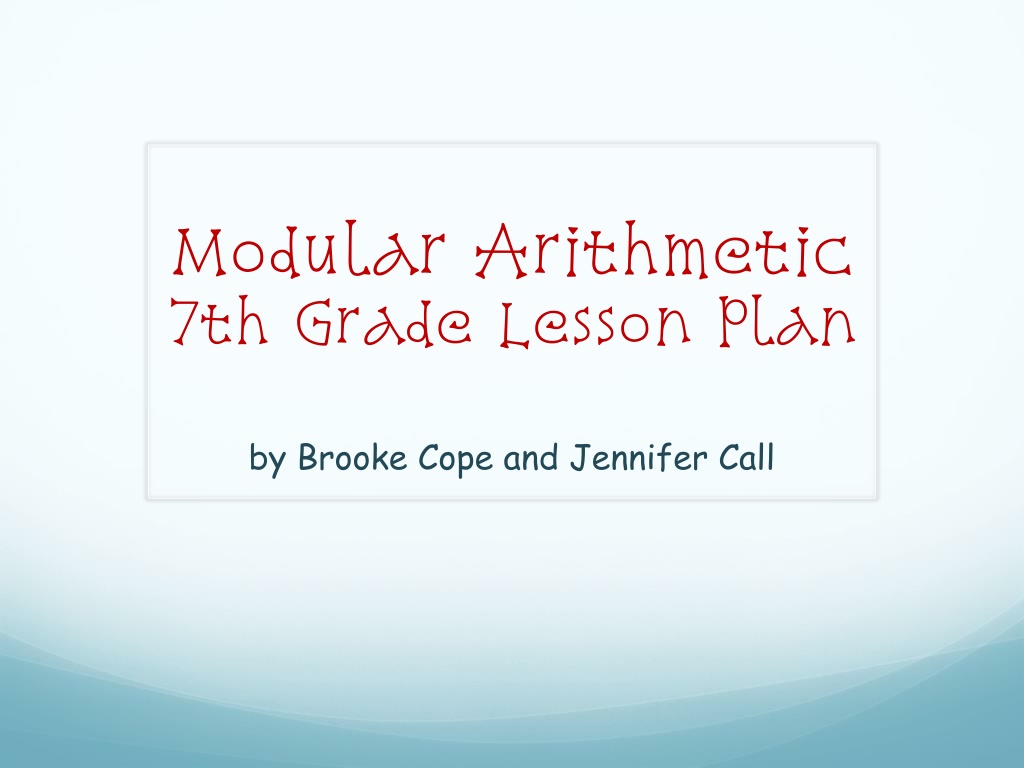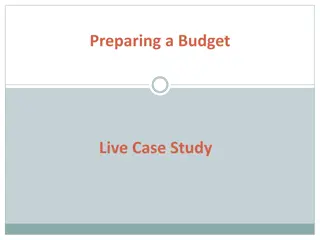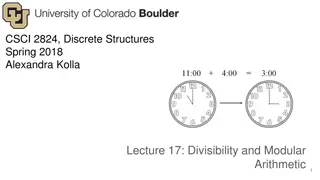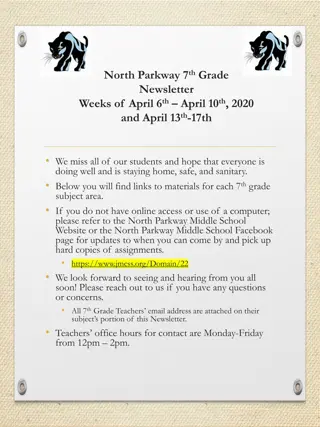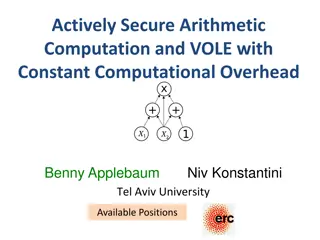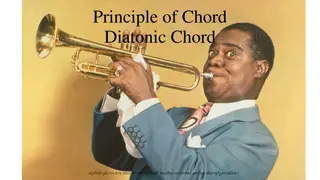Modular Arithmetic and Time Concepts in 7th Grade Math
Delve into the world of modular arithmetic and time calculations with this 7th-grade lesson plan. Students will learn how to determine future times based on modular arithmetic principles, model different time scenarios, and understand concepts like congruence in time calculations. Through engaging activities and real-world examples, students will enhance their mathematical thinking skills.
Download Presentation

Please find below an Image/Link to download the presentation.
The content on the website is provided AS IS for your information and personal use only. It may not be sold, licensed, or shared on other websites without obtaining consent from the author.If you encounter any issues during the download, it is possible that the publisher has removed the file from their server.
You are allowed to download the files provided on this website for personal or commercial use, subject to the condition that they are used lawfully. All files are the property of their respective owners.
The content on the website is provided AS IS for your information and personal use only. It may not be sold, licensed, or shared on other websites without obtaining consent from the author.
E N D
Presentation Transcript
Modular Arithmetic 7th Grade Lesson Plan by Brooke Cope and Jennifer Call
What time will the clock show? It is now 5 o clock; what time will it be in 2 hours? 7 o clock What time will it be 5 hours after 9 o clock? 2 o clock What is 26 hours after 8 o clock? 10 o clock It is 3 o clock now; what time will it be in 100 hours? 7 o clock How can you model each situation? Ideas come from Student Explorations in Mathematics, May 2012, 1-8
Joshs favorite song, Livin on a prayer plays on a radio station at 9 o clock every day. How many hours until Josh hears his song again, if it is Is there more than one possible answer? 5 o clock? 4 hours, 16 hours, 28 hours, 40 hours, 52 hours, . 10 o clock? 11 hours, 23 hours, 35 hours, 47 hours, 59 hours, . 9 o clock? 12 hours, 24 hours, 36 hours, 48 hours, 60 hours, .
What day will it be? Today is Monday; what day will it be in 13 days? Sunday Today is Thursday; what day will it be 23 days before? Tuesday Today is Sunday; what day will it be in 49 days? Sunday Every Tuesday is Taco Tuesday at Alyssa s favorite restaurant. If it is Saturday, how many days until can enjoy Taco Tuesday again? 3 days, 10 days, 17 days, 24 days, 33 days,
Introduction to Modular Arithmetic Time is Divided to Two Twelve Hour Periods this sets up a situation for mod 12 arithmetic, instead of 1 through 12, we will use 0 through 11. It is now 5 o clock; what time will it be in 2 hours? 5 (mod12) + 2 (mod12) = 7 (mod12) What time will it be 5 hours after 9 o clock? 5 (mod12) + 9 (mod12) = 2 (mod12) What is 26 hours after 8 o clock? 26 is 2 in (mod 12); 2 (mod12) + 8 (mod12) = 10 (mod12) It is 3 o clock now; what time will it be in 100 hours? 100 is 4 in (mod 12); 4 (mod12) + 3 (mod12) = 7 (mod12)
Modular Congruence Josh s favorite song, Livin on a prayer plays on a radio station at 9 o clock every day. How many hours until Josh hears his song again, if it is 5 o clock? 4 hours, 16 hours, 28 hours, 40 hours, 52 hours, . 10 o clock? 11 hours, 23 hours, 35 hours, 47 hours, 59 hours, . 9 o clock? 12 hours, 24 hours, 36 hours, 48 hours, 60 hours, .
In order to calculate a check digit, we will need to understand the basics of a college topic Whenever you divide a number, you can write the division problem in the following format: A / B = Q with remainder R Identify the quotient, dividend, and divisor in the equation above. Write the following division problems in the format above. 1. 12 5 2. 17 4
In modular arithmetic, we're mostly interested in the remainder. So A / B = Q with remainder R becomes A mod B = R. Write the following division problems in the modular arithmetic format. Then find the solution. 4. 12 5 5. 17 4 7. 42 6 8. 27 8 Find the solution to each equation written in modular arithmetic format. 10. 23 mod 4 11. 37 mod 5 13. 51 mod 7 14. 69 mod 8
With so many identification numbers and codes used in commerce and other places, it's important to be able to "check" that th A check digit is added somewhere in the identifying number to reduce errors made by humans or machines. 9781861978769bookland by BillPE Some of the errors that check digits detect are the following: single digit errors transposition errors phonetic errors replacing 1 with 2 switching 12 with 21 using "50" instead of "15"
In 1970, books began to be published with a 10-digit ISBN (International Standard Book Numbers). The first nine numbers helped The first 9-digits of the ISBN for The Hobbit are 0-618-00221. Follow the steps below to determine the check digit. 1. Write the formula below replacing the letters with the digits from the ISBN. (a x 10) + (b x 9) + (c x 8) + (d x 7) + (e x 6) + (f x 5) + (g x 4) + (h x 3) + (i x 2) = (0 x 10) + (6 x 9) + (1 x 8) + (8 x 7) + (0 x 6) + (0 x 5) + (2 x 4) + (2 x 3) + (1 x 2) 2. Evaluate the expression. = 0 + 54 + 8 + 56 + 0 + 0 + 8 + 6 + 2 = 134 3. Divide the sum by 11. Find the remainder. 134 mod 11 = 2 4. The check digit is the difference of 11 and the remainder. 11 - 2 = 9
The first nine-digits of the ISBN for Harry Potter and the Sorcerer's Stone The check digit is 3. Not including the check digit, how many unique ISBNs are there? x x x x x x x x 1,000,000,000 unique ISBNs Why is this a problem?
Since January 1, 2007, books are now assigned a 13-digit ISBN number. A three digit EAN (European Article Number) was added to The first 12-digits of the ISBN for The Hunger Games are 978-0-439-02348. Follow the steps below to determine the check digit. 1. Write the formula below replacing the letters with the digits from the ISBN. (a x 1) + (b x 3) + (c x 1) + (d x 3) + (e x 1) + (f x 3) + (g x 1) + (h x 3) + (i x 1) + (j x 3) + (k x 1) + (l x 3) = (9 x 1) + (7 x 3) + (8 x 1) + (0 x 3) + (4 x 1) + (3 x 3) + (9 x 1) + (0 x 3) + (2 x 1) + (3 2. Evaluate the expression. = 9 + 21 + 8 + 0 + 4 + 9 + 9 + 0 + 2 + 9 + 4 +24 = 99 3. Divide the sum by 10. Find the remainder. 99 mod 10 = 9 4. The check digit is the difference of 10 and the remainder. 10 - 9 = 1
The first twelve-digits of the ISBN for Twilight are 978-031616017. Find the check digit. The check digit is 9. Not including the check digit, how many unique ISBNs are there with the 13-digit code? = 10,000,000,000,000 unique ISBNs
Ideas for improving the checkout process were started in the Traditional UPC codes are 12 digits long. The first digit indicates the type of
The first 11-digits of the UPC for a box of graham crackers are 0-11110-09108. Follow the steps below to determine the check 1. Find the sum of all of the odd place-value digits. Multiply the sum by 3. = 0 + 1 + 1 + 0 + 1 + 8 = 11 11 x 3 = 33 2. Find the sum of all of the even place-value digits. Add this sum to the above product. = 1 + 1 + 0 + 9 + 0 = 11 11 + 33 = 44 3. Divide the sum by 10. Find the remainder. 44 mod 10 = 4 4. The check digit is the difference of 10 and the remainder. 10 - 4 = 6
The first 11 digits of the UPC for a box of cereal are 0-16000- The check digit is 7. Not including the check digit, how many unique UPCs are there? 100,000,000,000 unique UPCs
Additional Activity Time ?
Additional Activities for the Classroom 7thgrade honors core: systems with different bases: http://labyrinth.thinkport.org/www/educators/resources/lessons/shipping_grade7. pdf http://www.mathmaniacs.org/lessons/01-binary/ http://k12math.com/math-concepts/numbers/bases.htm http://math.about.com/od/calculuslessons/a/changebase.htm http://www.shodor.org/interactivate/activities/NumberBaseClocks/ http://www.discoveryeducation.com/teachers/free-lesson-plans/concepts-in- numbertheory.cfm http://math.sfsu.edu/cm2/papers/mikeh.p2.pdf
7th Grade Utah Honors Core Cluster Title: Codes Standard: Examine the use of mathematics in creating codes. Concepts and Skills to Master Explore codes used in commerce such as check digits, UPC codes, and bank numbers. Guiding Instructional Questions How does the use of codes facilitate commerce and other aspects of everyday life? Why do stores scan your receipt when you return an item? Instructional Strategies Collect a variety of UPCs and compare the codes to investigate product information.
